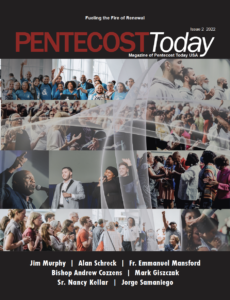The Catholic Charismatic Renewal as it exists today is the outgrowth from a retreat held in February 1967 of several faculty members and students from Duquesne University. Many of the students – though not all – experienced a movement of God’s Spirit called being “baptized in the Holy Spirit.” The professors had previously been “baptized in the Spirit” a week or two before. God’s action was also prepared for in a very human way by the students’ prayerful preparation in reading the Acts of the Apostles and a book entitled The Cross and the Switchblade.
What happened quickly spread to graduate students and professors at the University of Notre Dame and others serving in campus ministry in Lansing, Michigan. It continued to spread so that, as of this date, the Catholic Charismatic Renewal exists in over 238 countries in the world, having touched over 100 million Catholics in its nearly 40-year existence.
We recommend An Introduction to the Catholic Charismatic Renewal by John and Therese Boucher published by Servant Publications [Servant Publications recently sold its Catholic Charismatic section to St. Anthony Messenger Press] and also available from LaSalle Company (formerly Charismatic Renewal Services).
In 1975 Pope Paul VI greeted ten thousand Catholic charismatics from all over the world at the ninth international conference of the Renewal, “The Church and the world need more than ever that ‘the miracle of Pentecost should continue in history’ . . . How could this ‘spiritual renewal’ not be ‘good fortune’ for the Church and the world?” [others have translated “good fortune” as “a chance”]
Pope John Paul II has been an enthusiastic supporter of the Catholic Charismatic Renewal. In 1979 soon after becoming Pope he said, “I am convinced that this movement is a sign of the Spirit’s action . . . a very important component in the total renewal of the Church.” He has met with the international leaders of the Renewal on a number of occasions, and regularly sends greetings to National and International Conferences on the Renewal.
As early as 1969, only two years after the Renewal started, the U.S. Bishops investigated the fledgling movement and the Committee on Doctrine wrote that “theologically the movement has legitimate reasons of existence. It has a strong biblical basis. It would be difficult to inhibit the working of the Spirit which manifested itself so abundantly in the early Church.”
Subsequent statements in 1975, 1984 and 1997 have been equally affirming.
The 1984 Statement, A Pastoral Statement on the Catholic Charismatic Renewal, concluded with these words:
We wish those in the charismatic renewal to know that we make our own the view of Yves Congar: “The charismatic renewal is a grace for the Church.” We assure those in the charismatic renewal of the support they enjoy from the bishops of the United States, and we encourage them in their efforts to renew the life of the Church. (39)
The Statement also says:
Echoing the words of Pope John Paul II, we commend the charismatic renewal to the priests of the United States: “The priest, for his part, cannot exercise his service on behalf of the renewal unless and until he adopts a welcoming attitude toward it, based on the desire he shares with every Christian by baptism to grow in the gifts of the Holy Spirit” (May 7, 1981). The priest’s responsibility to give pastoral guidance remains, even though an individual priest may not be a participant in the renewal. (37)
In 1997 “on the occasion of the Catholic Charismatic Renewal’s thirtieth anniversary” we, the U.S. Bishops’ Ad Hoc Committee on the Catholic Charismatic Renewal, want to affirm again all those Catholics involved in this movement of the Holy Spirit in our day. We, likewise, ‘encourage them in their efforts to renew the life of the Church.’” (Grace for the New Springtime). You may read the full text in English or Spanish.
The Statement concludes, “Thus, we can say again, with great thanksgiving and enthusiasm, that in the Catholic Charismatic Renewal and in the grace of baptism in the Holy Spirit we see God’s outpouring of a new Pentecost.”
At the core of the Catholic Charismatic Renewal is the “grace of Pentecost” also known as baptism in the Holy Spirit.
In a key statement issued in 1991 addressed “to the bishops and pastoral leaders of the Catholic church in the United States,” entitled Fanning the Flame: What Does Baptism in the Holy Spirit Have to Do with Christian Initiation? “baptism in the Holy Spirit” refers to both Christian initiation and to its reawakening in Christian experience. “We believe that this gift of the baptism in the Holy Spirit belongs to the Christian inheritance of all those sacramentally initiated into the church” (p. 10).
While not a theological statement the U.S. Bishops Ad Hoc Committee defines baptism in this way:
As experienced in the Catholic Charismatic Renewal baptism in the Holy Spirit makes Jesus Christ known and loved as Lord and Savior, establishes or reestablishes an immediacy of relationship with all those persons on the Trinity, and through inner transformation affects the whole of the Christian’s life. There is new life and a new conscious awareness of God’s power and presence. It is a grace experience which touches every dimension of the Church’s life: worship, preaching, teaching, ministry, evangelism, prayer and spirituality, service and community. Because of this, it is our conviction that baptism in the Holy Spirit, understood as the reawakening in Christian experience of the presence and action of the Holy Spirit given in Christian initiation, and manifested in a broad range of charisms, including those closely associated with the Catholic Charismatic Renewal, is part of the normal Christian life.

 Click Here for us to pray for your intentions through our new website.
Click Here for us to pray for your intentions through our new website. 
